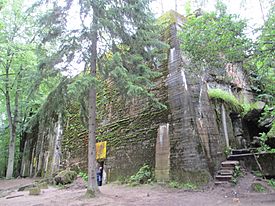Wolf's Lair facts for kids
Quick facts for kids Wolf's Lair |
|
|---|---|
| Wolfsschanze | |
| Part of Führerhauptquartiere | |
| Gierłoż Forest, Kętrzyn County, present-day Poland | |

Hitler's reinforced bunker at the Wolfsschanze
|
|
| Coordinates | 54°04′49″N 21°29′39″E / 54.0804°N 21.4941°E |
| Type | Blast-resistant camouflaged concrete bunkers |
| Site information | |
| Owner | Polish Government |
| Controlled by | Wilcze Gniazdo |
| Open to the public |
Yes |
| Condition | Mostly destroyed (in ruins) |
| Site history | |
| Built | 1941 (completed on 21 June 1941) |
| Built by | Hochtief AG Organisation Todt |
| In use | 3½ years |
| Materials | 2 m (6 ft 7 in) steel-reinforced concrete |
| Fate | Partially demolished by retreating German forces 24–25 January 1945 |
| Events | 20 July Plot |
| Garrison information | |
| Past commanders |
SS-Gruppenführer Johann Rattenhuber |
| Garrison | Reichssicherheitsdienst Führerbegleitbrigade |
| Occupants | Adolf Hitler Nazi Germany Oberkommando der Wehrmacht |
Wolf's Lair (German: Wolfsschanze; Polish: Wilczy Szaniec) was a secret military headquarters used by Adolf Hitler during World War II. It was hidden deep in a forest in what is now Poland. This complex was one of several special places built for Hitler to direct his armies. It was designed to be very strong and hard to find, like a hidden den for a wolf.
Contents
What Was Wolf's Lair?
Wolf's Lair was a large group of buildings, including bunkers and barracks. It was Hitler's main command center on the Eastern Front of World War II. This was where he spent most of his time during the war. The name "Wolf's Lair" came from Hitler's nickname, "Herr Wolf."
Building a Secret Base
The construction of Wolf's Lair began in 1940. It was built by a group called Organisation Todt. This group was known for building large military projects. They used a lot of steel-reinforced concrete to make the buildings very strong. The walls of the bunkers were up to 2 meters (6.5 feet) thick.
Hidden in the Forest
The headquarters was built in a thick forest. This helped to hide it from enemy planes. Workers also used camouflage nets and painted the buildings to blend in with the trees. The area was also protected by landmines and barbed wire. This made it very difficult for anyone to get in without permission.
Life at the Headquarters
Hitler spent over 800 days at Wolf's Lair between 1941 and 1944. Many important decisions about the war were made here. High-ranking military officers and officials also lived and worked at the complex. It was like a small, self-contained town.
Daily Routines
Life at Wolf's Lair was often tense. Hitler held many meetings with his generals. They discussed battle plans and war strategies. The complex had its own power station, water supply, and railway line. This allowed it to operate independently.
The 20 July Plot
One of the most famous events at Wolf's Lair was the 20 July Plot in 1944. This was an attempt by some German officers to assassinate Hitler. A bomb was placed in a meeting room where Hitler was present.
The Attempted Assassination
The bomb exploded, but Hitler survived with only minor injuries. The heavy oak table where the meeting was held protected him from the blast. Many people involved in the plot were later caught and punished. This event showed how dangerous and secretive life was at the headquarters.
The End of Wolf's Lair
As the Soviet army advanced in late 1944, Hitler left Wolf's Lair for the last time. The German forces decided to destroy the complex. They wanted to prevent it from falling into enemy hands.
Demolition and Ruins
On January 24-25, 1945, the Germans used explosives to blow up the bunkers and buildings. They tried to destroy everything. However, the structures were so strong that many parts remained as ruins. Today, Wolf's Lair is a historical site. Visitors can explore the remains of the bunkers and learn about its history.
See also
 In Spanish: Guarida del Lobo para niños
In Spanish: Guarida del Lobo para niños

